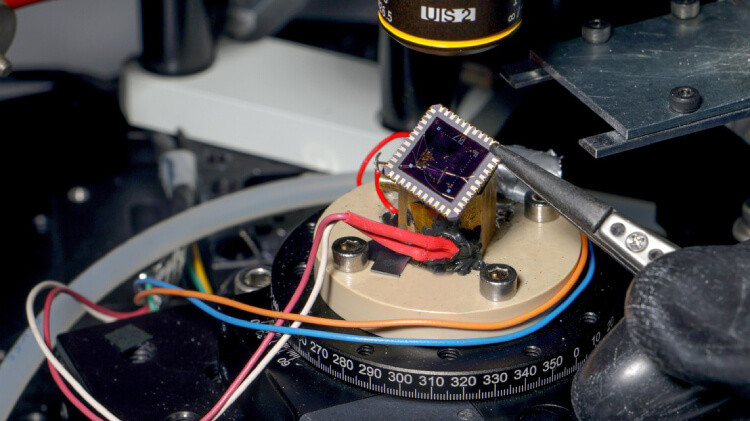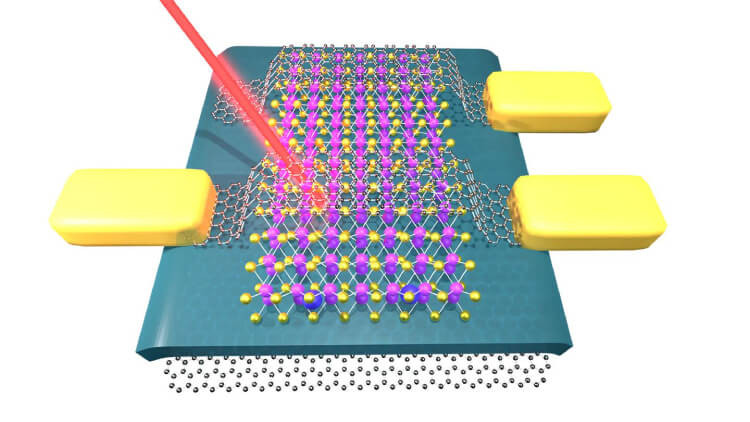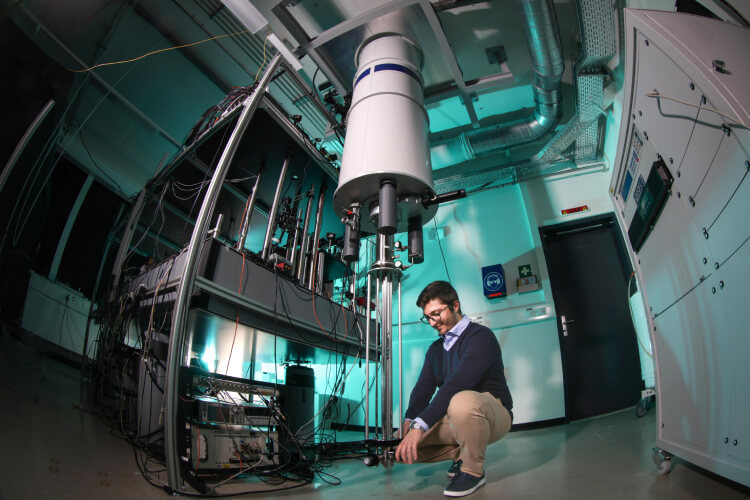2D Device Keeps Quantum Computers Cool Efficiently
Insights | 23-07-2024 | By Robin Mitchell

The LANES lab's 2D device of graphene and indium selenide. Credit: Alain Herzog/EPFL
In the field of quantum computing, a groundbreaking 2D device made of graphene and indium selenide has emerged as a potential solution to the cooling challenge faced by quantum systems. Developed by researchers at EPFL, this innovative device operates efficiently at ultra-low temperatures required for quantum systems, offering a promising avenue for advancing quantum technologies. By harnessing the Nernst effect and utilising a laser as a heat source, this device could transform cooling systems for quantum computing. What challenges do quantum computers face when it comes to keeping cool, what did the researchers demonstrate, and how might the integration of this device into existing quantum circuits enhance the performance of quantum computers in practical applications?
Key Things to Know:
- The EPFL team's innovative 2D device made of graphene and indium selenide efficiently converts heat into electricity, addressing the cooling challenges in quantum systems.
- The device leverages the Nernst effect, allowing precise electrical modulation for enhanced performance and scalability in quantum computing technologies.
- This breakthrough in material science demonstrates the porectential for significant cost-efficiency and energy savings in maintaining quantum systems at ultralow temperatures.
- The integration of this device could transform thermal management in quantum circuits, paving the way for advanced and scalable quantum computing solutions.
The Temperature Barrier in Quantum Computing Technology
As the world grapples with the complexities of artificial intelligence and data processing, the transformative power of quantum computing is gaining momentum. By leveraging the inherent properties of quantum systems, quantum computers can tackle complex algorithms and calculations with unprecedented speed and efficiency, outperforming traditional computing systems. However, the quantum computing industry faces a major impediment in realising the full potential of these systems: maintaining quantum states at extremely low temperatures.
The heart of a quantum computer is the qubit, the quantum equivalent of the classical bit. Unlike classical bits, qubits utilise the quantum property of superposition, allowing them to exist in multiple states simultaneously. However, this fragile nature of quantum states means that qubits are prone to decay, making temperature control a paramount concern. Even the slightest increase in temperature can disrupt the delicate balance of quantum states, leading to loss of information and reduced system performance. Thus, maintaining temperatures in the millikelvin range is crucial for the effective operation of quantum computers.
Cryogenic cooling methods, primarily relying on liquid helium and nitrogen, have been the mainstay of quantum cooling. These fluids can be used to cool certain materials to near absolute zero, making them ideal for current quantum computing applications. However, the inefficiencies associated with transferring heat from a qubit to a cooling medium and the limitations of current cooling technologies are major barriers to the advancement of quantum computing technology. The integration of cryogenic cooling systems with quantum circuits also poses significant challenges, including the need for specialised infrastructure and reduced scalability for large-scale systems. Thus, the reliance on liquid coolants limits the practical implementation of quantum computers, hindering their potential for real-world applications.
The temperature control challenge also has implications for the scalability and commercialisation of quantum computing systems. The complexity and cost of maintaining quantum states at low temperatures restrict the scalability of current quantum computing technology, making large-scale systems difficult to implement. The integration of on-chip cooling solutions is essential for overcoming these challenges, but the engineering complexities involved in achieving this remain a major hurdle in the development of practical quantum computers. Thus, the temperature barrier poses a significant obstacle to the widespread adoption and commercialisation of quantum computing technology.
Quantum Cooling Technologies for Efficient Scalable Quantum Computers
To address the issues of quantum cooling, a team of researchers from the Laboratory of Nanoscale Electronics and Structures (LANES) at EPFL have recently developed an innovative 2D device that combines graphene and indium selenide to harness heat efficiently from quantum systems. Their innovative solution leverages the Nernst effect, a phenomenon where a temperature difference between two points in a material results in a voltage difference, and manipulates this effect to convert heat into electricity with high efficiency.
 3D diagram of the device featuring an indium selenide channel (purple), graphene electrodes (horizontal bands), and a laser beam (red) © LANES EPFL
3D diagram of the device featuring an indium selenide channel (purple), graphene electrodes (horizontal bands), and a laser beam (red) © LANES EPFL
In a recent study published in Nature Nanotechnology, EPFL engineers have demonstrated the integration of a graphene and indium selenide heterostructure to achieve record-breaking Nernst coefficients at ultralow temperatures. This significant advancement in material science underscores the potential for the Nernst effect to be finely tuned for optimal performance in quantum cooling applications.

Gabriele Pasquale at the LANES lab with the dilution refrigerator © Alain Herzog
Material Properties and Their Impact
The choice of graphene and indium selenide as the primary materials in the device is crucial for achieving this efficient cooling technique. Graphene's exceptional electrical conductivity enables fast and efficient electronic transport, while indium selenide's semiconductor properties allow for controlling the efficiency of the Nernst effect. This strategic combination enhances the device's ability to convert heat into electricity, paving the way for improved quantum computing technologies.
According to the researchers, the combination of graphene's high electron mobility and indium selenide's low resistivity allows the device to operate efficiently even at temperatures lower than outer space. This discovery could transform thermal management in quantum circuits, making it feasible to maintain the required low temperatures without the inefficiencies of current methods.
Electrical Modulation of the Nernst Effect
The researchers have also exploited the ability to electrically modulate the efficiency of the Nernst effect, a key feature of their 2D device. This electrical modulation enables precise control over the conversion of heat into electricity, boosting the device's efficiency and enhancing its potential for scaling up to larger devices. The team's breakthrough in manipulating the Nernst effect could lead to new cooling strategies for future quantum computing systems, pushing the limits of quantum computing technology into new realms.
Furthermore, the electrically tunable nature of the device provides a flexible approach to managing heat in quantum systems. This tunability could lead to the development of bespoke cooling solutions tailored to specific quantum applications, further enhancing the practical implementation of quantum technologies in real-world scenarios.
Moreover, this breakthrough in quantum cooling technology holds the promise of significantly reducing the operational costs and energy requirements associated with maintaining quantum systems at millikelvin temperatures. This cost-efficiency could accelerate the adoption of quantum computing technologies across various sectors, thereby expanding the impact of quantum solutions on global industries.
Long-Term Implications
The implications of this discovery are significant, both in the short and long term. By maintaining quantum states at ultra-low temperatures with greater efficiency, the researchers have paved the way for the advancement of quantum computers. The scalability of these devices could lead to the widespread adoption of quantum computing in various industries, from material science to medicine, opening up new possibilities for complex algorithms in quantum systems.
Notably, the EPFL team's device utilises the photo-Nernst effect, wherein a temperature gradient created by laser illumination generates an electric voltage. This innovative approach not only improves the efficiency of thermal management in quantum systems but also provides a new pathway for integrating optical elements into quantum circuits, potentially leading to new hybrid quantum technologies.
The future of quantum cooling holds promise with the EPFL team's groundbreaking research on graphene and indium selenide devices. The strategic combination of conductivity and semiconductor properties, along with the electrical modulation of the Nernst effect, sets the stage for enhancing the efficiency of heat conversion in quantum computers. As the field of quantum computing continues to evolve, these advancements in cooling technologies will play a crucial role in the quest for scalable and reliable quantum systems.
Quantum Leap with Graphene and Indium Selenide Integration
As researchers and engineers embark on optimising this cooling technology, the future holds promise for improving the scalability and efficiency of quantum computing, a crucial step towards unlocking the vast potential of quantum solutions.
The integration of the graphene and indium selenide device into quantum circuits could usher in a new era of quantum technology, marked by improved efficiency and performance. The combination of graphene's electrical conductivity and indium selenide's semiconductor properties enables versatile applications beyond quantum computing, opening up new avenues for research and innovation in material science and medical research. The potential applications of this breakthrough technology extend beyond the realm of quantum computing, paving the way for a broader impact on various industries.
Future research and advancements in the field of quantum technology could very well build upon the foundation laid by the integration of the graphene and indium selenide device. As researchers and engineers optimise this cooling technology, they may unlock new possibilities for enhancing the stability and performance of quantum systems, leading to improved scalability and efficiency in quantum computing.
The integration of a 2D device made from graphene and indium selenide into quantum circuits represents a significant advancement in quantum technology, enabling efficient cooling of quantum systems to millikelvin temperatures. This breakthrough opens up new opportunities for material science and medical research, in addition to improving the performance and stability of quantum computing operations.
As researchers and engineers optimise this cooling technology, the future holds promise for advancing the efficiency and scalability of quantum computing, a crucial step towards unlocking the vast potential of quantum solutions.

